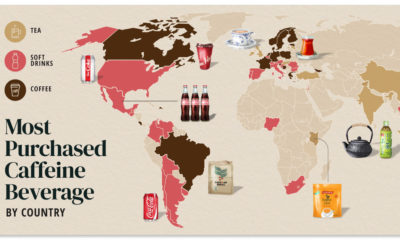Not a Drop to Drink: America’s Water Crisis
Almost a year ago, we had wrote about how we are potentially on the path to global Peak Water. Today’s infographic elaborates more on the problem in the United States on a national basis . Right now, the average American consumes about 100 gallons of water per day both directly and indirectly. This is a problem of conservation and efficiency as much as it is supply, as the aging water infrastructure had its last upgrade during the Reagan era. In the next 20 years, it is expected that $1.5 trillion needs to be spent on building new infrastructure alone. At the same time, only 0.3% of freshwater occurs in lakes and streams. With massive droughts occurring in the West of the United States and rivers such as the Colorado River drying up, clearly initial supply is just as much of a concern in America’s water crisis. To solve the problem of less reliable freshwater supply, countries such as Israel have been turning to desalination. Recently, the government built a megascale $500 million desalination plant to supply up to 20% of the households with regular water supply. Investors know that with every great problem, there are opportunities abound in companies that can provide solutions. Previously, Sprott Global had outlined three distinct areas that people looking to invest in water management solutions should consider: adaption to water systems to handle changing weather patterns, improving water safety, and managing storm water in urban areas. Original graphic by: Last Call at the Oasis
on Over recent decades, farmers have been able to more than double their production of crops thanks to fertilizers and the vital nutrients they contain. When crops are harvested, the essential nutrients are taken away with them to the dining table, resulting in the depletion of these nutrients in the soil. To replenish these nutrients, fertilizers are needed, and the cycle continues. The above infographic by Brazil Potash shows the role that each macronutrient plays in growing healthy, high-yielding crops.
Food for Growth
Nitrogen, phosphorus, and potassium (NPK) are three primary macronutrients that are the building blocks of the global fertilizer industry. Each plays a key role in plant nutrition and promoting crop growth with higher yields. Let’s take a look at how each macronutrient affects plant growth. If crops lack NPK macronutrients, they become vulnerable to various stresses caused by weather conditions, pests, and diseases. Therefore, it is crucial to maintain a balance of all three macronutrients for the production of healthy, high-yielding crops.
The Importance of Fertilizers
Humans identified the importance of using fertilizers, such as manure, to nourish crops dating back to nearly 6,000 to 2,400 BC. As agriculture became more intensive and large-scale, farmers began to experiment with different types of fertilizers. Today advanced chemical fertilizers are used across the globe to enhance global crop production. There are a myriad of factors that affect soil type, and so the farmable land must have a healthy balance of all three macronutrients to support high-yielding, healthy crops. Consequently, arable land around the world varies in the amount and type of fertilizer it needs. Fertilizers play an integral role in strengthening food security, and a supply of locally available fertilizer is needed in supporting global food systems in an ever-growing world. Brazil is one of the largest exporters of agricultural goods in the world. However, the country is vulnerable as it relies on importing more than 95% of its potash to support crop growth. Brazil Potash is developing a new potash project in Brazil to ensure a stable domestic source of this nutrient-rich fertilizer critical for global food security. Click here to learn more about fertilizer and food production in Brazil.

































